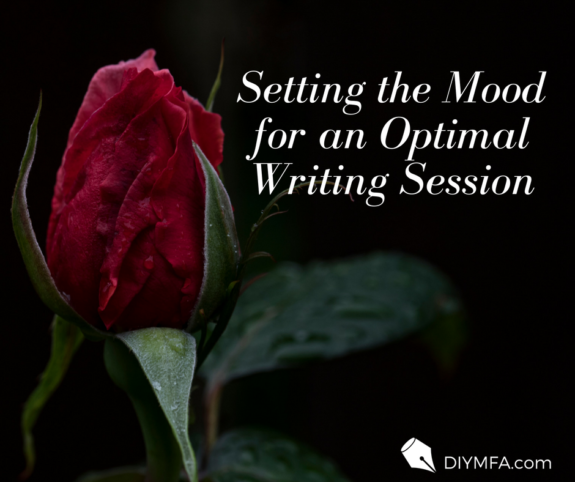When it comes to getting in the “zone” for writing, sometimes it’s easy and sometimes it’s really hard. There are days when I’m just not “in the mood” and I can’t sit around waiting for inspiration to strike. Instead, I’ve learned a few tricks to help me set the mood even when if feels like the well has run dry. You know that saying, “fake it ‘til you make it”? It’s the mantra I whisper over and over until my muse decides to cooperate. (Some days she never does.) Here are a couple of ways I “fake it” when I need instant inspiration.
1) Establish Writing Session Rituals
I’ve been writing with the same type of notebook and pen for years, and it’s not uncommon for writers to have rituals like this. I once heard of a writer who wore different hats for drafting and editing so she could get into the mindset of the different tasks. Other writers have a particular place where they like to write or a preferred beverage sitting next to them as they work. You name the quirk and chances are, some writer out there has it. Whatever the ritual, though, there has to be a reason why writers do this and why it works. Here’s my guess: these rituals are sensory cues that remind your brain “OK, time to buckle down and write.” While they may seem silly at times, they help get you into that writing mood even on days when your muse has decided to go on vacation.
2) Tap Into the Five Senses
This goes hand-in-hand with the idea of setting up rituals to create your optimal writing session. Engaging the senses is sort of like jump-starting a car; it can jolt your brain out of its comfort zone and into action, helping you get those writerly juices flowing. Everyone has one of the five senses that really pushes his or her creative buttons. For some writers, it’s sounds or colors. For others, texture or taste. Personally, I find smell to be especially powerful, and I often need only one whiff of a familiar scent to get my brain right back into a particular project.
3) Break Out of Routine
While rituals and sensory cues can be a great reminder that it’s time to get to work, sometimes they can get out of control. It’s a fine line between using rituals to kick-start your writing versus depending so much on those routines that you can’t write without them. Suppose one morning Zabar’s happens to be out of your favorite chocolate eclairs. You can’t just have a meltdown in the middle of the baked-goods aisle. Instead, you need to use this change in routine to your advantage. Sometimes all it takes is one small, new thing to boost you out of a writing rut.
4) Set a Timer
It never ceases to amaze me what a simple time constraint can do for my productivity. If I sit down with a huge chunk of writing time ahead of me, chances are I’ll waste at least half of it reading email, checking Twitter or surfing the web. If, on the other hand, I have only 30 minutes to work you can bet I’ll be writing up a storm during that short block of time. Sometimes I’ll purposefully schedule appointments with oddball blocks of time in between where I know I’ll be forced to work fast.
5) Realize There Is No Such Thing as the “Right Mood” to Write
In the end, you don’t need the right pen or the right egg timer or even the right chocolate eclair in order to write. Just apply some glue to the seat of your pants and sit your backside in that chair. (OK, the glue is optional.) Seriously, though, some writers get so caught up in getting our surroundings “just so” that they never get started on the real work: writing. Sometimes you just have to dive in and figure out later whether you know how to swim. Or as Ray Bradbury put it: “First you jump off the cliff and build your wings on the way down.”







